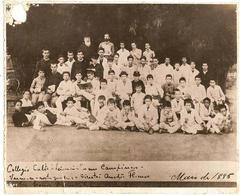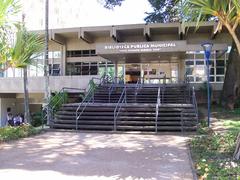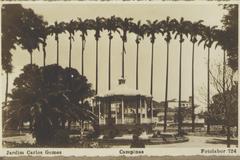
Comprehensive Guide to Visiting Campinas, São Paulo, Brazil
Date: 13/08/2024
Captivating Introduction
Welcome to Campinas, São Paulo, Brazil—a city where history, culture, and innovation collide in a mesmerizing blend. Dubbed the ‘Silicon Valley of Brazil,’ Campinas is more than just a tech hub; it’s a living tapestry woven from centuries of adventure, tragedy, and triumph. Picture this: it’s the 1730s, and what is now a bustling metropolis was merely a jungle clearing, a resting spot for caravans (Britannica Kids). Fast forward to 1774, when Barreto Leme founded the city as a station for the Bandeirantes, daring explorers on the hunt for minerals and slaves (Wikipedia).
The 19th century saw Campinas transformed into an agricultural powerhouse, with coffee, cotton, and sugarcane plantations sprawling across the landscape. The arrival of the railway in 1867 was the catalyst for rapid growth, connecting the city to São Paulo and the Santos seaport (Wikipedia). However, the late 19th century brought a yellow fever epidemic that claimed over 25% of the population, leading to significant changes in public health and infrastructure (Wikipedia).
As the 20th century dawned, Campinas evolved into an industrial and educational hub, thanks in part to the opening of the Anhanguera Highway in 1938 and the establishment of institutions like UNICAMP in 1962 (Wikipedia). Today, the city is a vibrant cultural mosaic and a technological innovator, home to icons like opera composer Carlos Gomes and early photography pioneer Hércules Florence (Britannica). So, whether you’re a history buff, a culture vulture, or a tech enthusiast, Campinas offers a rich tapestry of experiences waiting to be explored.
Table of Contents
Historical Background
Early Settlement and Foundation
Did you know Campinas is dubbed the ‘Silicon Valley of Brazil’? This vibrant city, nestled in the state of São Paulo, has a fascinating history dating back to the 18th century. Imagine the 1730s, when it was merely a resting place for caravans cutting through the jungle. The name ‘Campinas’ means ‘fields’ in Portuguese, a nod to the clearings amidst the dense wilderness (Britannica Kids). Officially founded on July 14, 1774, by Barreto Leme, it started as a humble outpost for the ‘Bandeirantes,’ adventurers in search of minerals and slaves (Wikipedia).
Growth in the 19th Century
By the 19th century, Campinas was buzzing with agricultural activity. Picture vast coffee, cotton, and sugarcane plantations blanketing the landscape. The arrival of the railway in 1867, connecting São Paulo to the Santos seaport, was like adding jet fuel to the city’s growth (Wikipedia).
Impact of Yellow Fever
The late 19th century brought dark days with a yellow fever epidemic that claimed over 25% of the population. This tragedy led to sweeping changes in infrastructure and public health. The city’s crest and flag, adorned with the phoenix, symbolize its remarkable rebirth (Wikipedia).
Industrialization and Immigration
Post-abolition of slavery in 1888, Campinas welcomed waves of immigrants, mainly Italians, who fueled its industrial boom. Imagine foundries, textile mills, and agricultural equipment factories sprouting up, thanks to these industrious newcomers (Britannica).
20th Century Developments
The 20th century was a transformative era. The Anhanguera Highway, Brazil’s first, opened in 1938, tightly linking Campinas to the state’s heart. Educational and research institutions like the Instituto Agronômico de Campinas and UNICAMP, established in 1962, became pillars of progress (Wikipedia).
Cultural and Scientific Contributions
Campinas has gifted Brazil with cultural icons like opera composer Carlos Gomes and President Campos Salles. It was also home to Hércules Florence, an early photography pioneer (Wikipedia). Museums, theaters, and art galleries dot the city, enriching its cultural tapestry (Britannica).
Modern-Day Campinas
Today, Campinas is a bustling metropolis of over a million people, a tech hub worthy of its ‘Silicon Valley’ moniker. The city is a nexus of technological innovation, thanks to institutions like UNICAMP (Facts.net).
Key Historical Landmarks
Explore hidden gems like the Bosque dos Jequitibás, an urban park with a zoo and hiking trails, or the Torre do Castelo, a historic tower offering panoramic city views (Triplyzer).
Economic Significance
Campinas remains an economic powerhouse with a diverse economy spanning technology, agriculture, and finance. Its strategic location and superb transportation infrastructure, including an international airport, make it a vital hub (Britannica).
Significance
A Glimpse into the Past
Once upon a time, in 1774 to be precise, a city named Campinas was born. Founded by the adventurous Barreto Leme, this city started as a humble station for Bandeirantes—those daring explorers hunting for treasures and, well, Indian slaves. Fast forward to the 1800s, and Campinas had transformed into a bustling hub of sugarcane and coffee farming, setting the stage for its economic boom (Travelgrove).
Imagine the clatter of trains and the huffing of steam engines in 1867 when the railway connecting Santos to São Paulo was built. This railway didn’t just bring trains; it brought an end to slavery and a wave of industrialization. Immigrants flocked in, coffee was shipped far and wide, and Campinas flourished (Travelgrove).
A Cultural Mosaic
Campinas isn’t just an economic powerhouse; it’s a vibrant cultural tapestry. Think opera houses, theaters, and local performers dazzling audiences with their talents. This city loves its art and has the institutions to prove it—schools, hospitals, and charities that reflect a community deeply committed to cultural and social growth (Travelgrove).
Ever heard of Carlos Gomes? This opera maestro hails from Campinas. So does Hercules Florence, the inventive genius behind photography, mimeography, and photocopying. And let’s not forget Campos Salles, a Brazilian President born right here (Travelgrove).
From Fields to Factories
Campinas’ economic saga began with sugarcane and coffee fields, which laid the groundwork for its prosperity. The 1867 railway was a game-changer, turning the city into an industrial magnet. Banks sprung up, movie houses entertained, and radio stations broadcasted, all contributing to the economic crescendo (Travelgrove).
Today, Campinas thrives on a mix of industry and innovation. It’s got research centers pushing agricultural boundaries and educational institutions shaping future leaders. The city’s economic engine is well-oiled and roaring (Travelgrove).
Insider’s Guide to Exploring Campinas
Cultural Treasures
- Carlos Gomes Square: A tribute to the city’s musical heritage, complete with statues and monuments. Feel the artistry in the air!
- Museum of Image and Sound: Dive into the visual and auditory history of Campinas. It’s a sensory feast featuring local legends like Hercules Florence.
- Opera Houses and Theaters: Catch a performance and soak in the cultural vibrancy. The local talent will leave you spellbound.
Historical Gems
- Campinas Railway Station: Step back in time at this historic station and imagine the era when coffee was king.
- Jequitibá Woods Park: Wander among ancient trees, visit the cozy zoo, and uncover the park’s museum treasures.
Modern Marvels
- Shopping Centers: From Parque D. Pedro Shopping to Iguatemi Campinas, indulge in retail therapy and culinary delights.
- Dining: Savor traditional Brazilian flavors like feijoada and pão de queijo. Your taste buds will thank you.
Practical Tips for Your Trip
- Getting Around: Fly into Viracopos International Airport and explore the city via buses and taxis. Easy peasy!
- Where to Stay: Choose from luxury hotels to budget-friendly hostels. Top picks include Royal Palm Plaza Resort and Ibis Campinas.
- Stay Safe: Enjoy Campinas safely by sticking to well-lit areas and keeping an eye on your belongings.
Visitor Tips
Best Time to Visit
Planning a trip to Campinas? The sweet spot for your visit is from May to September when the weather is as cool as a cucumber, and the skies are drier than a witty remark. Temperatures range from a cozy 15°C to a pleasant 25°C, making it perfect for outdoor adventures. But if you’re a festival junkie, October to December is your golden ticket with a carnival of cultural events lighting up the city (Wild Trips).
Getting to Campinas
By Plane: Fly into Viracopos International Airport (VCP), just 13 miles from downtown. Hop on a local bus for a pocket-friendly R$4.50, or take a Lirabus shuttle for R$9. Feeling fancy? Grab a taxi and indulge in the scenic route (Kayak).
By Car: Buckle up! Campinas is a road tripper’s dream, connected by a top-notch network of motorways. Private operators keep the tolls high but the roads smoother than a samba rhythm. Either way, driving here is a cut above the Brazilian average (Wikivoyage).
Getting Around Campinas
Public Transport: Need a lift? The city’s buses are reliable and wallet-friendly, covering almost every nook and cranny of Campinas.
Taxis and Ride-Hailing Services: For a touch of comfort and convenience, especially when the sun dips, opt for official taxis or ride-hailing services like Uber. They are your best bet for navigating those dimly-lit or off-the-beaten-path areas (Wild Trips).
Safety Tips
Campinas is generally a safe haven for tourists, but a sprinkle of caution goes a long way. Keep your wits about you and follow these tips:
- Guard your belongings in crowded spaces.
- Steer clear of poorly lit or deserted areas after dark.
- Stick to official taxis or ride-hailing services at night.
- Stay alert and trust your instincts (Wild Trips).
Accommodation
From budget lodgings to luxurious stays, Campinas has it all. Check out these neighborhoods:
- Cambuí: The heartbeat of nightlife and dining.
- Taquaral: Family-friendly with parks galore.
- Downtown: Perfect for history buffs and shopaholics (Wild Trips).
Dining and Cuisine
Prepare your taste buds for a culinary rollercoaster! Must-try local delights include:
- Coxinha: Think of it as Brazil’s answer to a meat-stuffed doughnut. Estação Barão Bar serves the best coxinhas in town, where two can feast for just R$15 (Kayak).
- Torta Holandesa: A Dutch-influenced dessert that’ll have you coming back for seconds.
Shopping
Shop till you drop at these hotspots:
- Iguatemi Campinas: A sprawling mall with everything under one roof.
- Mercado Municipal: A traditional market brimming with fresh produce, local treats, and handmade crafts (Kayak).
Cultural and Historical Sites
Dive into Campinas’ rich tapestry of culture and history with these must-visit sites:
- Casa do Lago: Free exhibitions and outdoor movie screenings make this a cultural gem (Kayak).
- Basilica de Nossa Senhora do Carmo: A 19th-century marvel with stunning stained glass and intricate carvings (Wild Trips).
- Museu de História Natural: A treasure trove of fossils and Brazilian fauna (Wild Trips).
Outdoor Activities
For nature lovers and adventure seekers, Campinas is a paradise:
- Bosque dos Jequitibás: An urban park with a zoo, aquarium, and walking trails, perfect for a family outing.
- Parque Portugal: Also known as Taquaral Park, it boasts a large lake, walking and cycling paths, and paddle boats (Wild Trips).
Day Trips
Venture beyond Campinas with these delightful day trips:
- Jaguariúna: Hop on an old-style train and journey through the countryside for a nostalgic travel experience.
- Serra Negra: This mountain town offers breathtaking landscapes, fresh air, and thermal springs. Take a cable car ride or explore the town’s charming cafes and restaurants (Wild Trips).
By following these tips, you’ll unlock the magic of Campinas, reveling in its cultural treasures, vibrant city life, and stunning natural beauty. Ready to explore? Download Audiala, your ultimate tour guide app, for an unforgettable journey through Campinas!
Call to Action
From its humble beginnings as a jungle outpost to its current status as a technological and cultural powerhouse, Campinas is a city that embodies resilience and innovation. Its journey through time is marked by triumphs and tribulations, from the tragedy of the yellow fever epidemic to the transformative industrialization and immigration waves of the 19th and 20th centuries (Wikipedia). Today, Campinas stands as a beacon of progress, offering a unique blend of historical landmarks, cultural treasures, and modern marvels.
Whether you’re wandering through the historic Bosque dos Jequitibás, exploring the cutting-edge research centers, or savoring a taste of local cuisine, Campinas promises an adventure that engages all your senses. For those looking to dive deeper into the city’s hidden gems and local secrets, the Audiala app is your perfect guide. With beautifully crafted audio guides that provide expert insights, Audiala transforms your visit into an immersive storytelling experience. So why wait? Download Audiala and unlock the captivating stories and secrets of Campinas, making your journey truly unforgettable.
References
- Campinas. (n.d.). In Britannica Kids. Retrieved from Britannica Kids
- Campinas. (n.d.). In Wikipedia. Retrieved from Wikipedia
- Campinas. (n.d.). In Britannica. Retrieved from Britannica
- Campinas. (n.d.). In Facts.net. Retrieved from Facts.net
- Things to Do in Campinas. (n.d.). Retrieved from Triplyzer
- Campinas History. (n.d.). In Travelgrove. Retrieved from Travelgrove
- Campinas - What to Visit. (n.d.). In Wild Trips. Retrieved from Wild Trips
- Campinas Travel Guide. (n.d.). In Kayak. Retrieved from Kayak
- Campinas Region. (n.d.). In Wikivoyage. Retrieved from Wikivoyage





